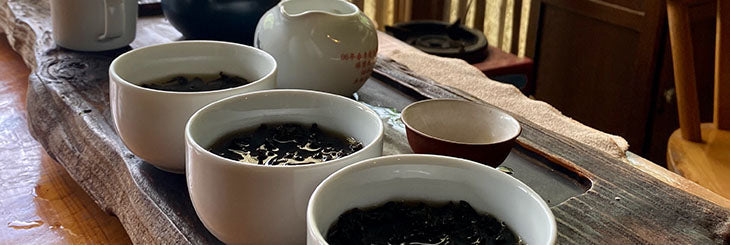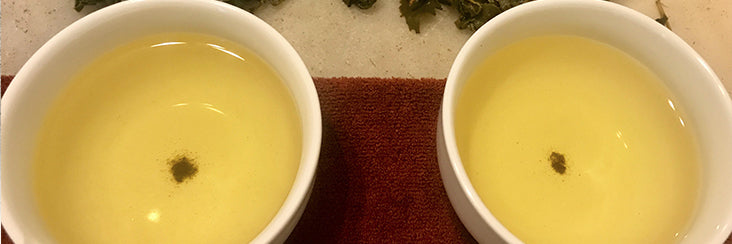News

Spring 2022 Looking Good for Taiwan Tea!
Reservoir levels in northern and central Taiwan are all almost at full capacity now. This shows Taiwan has had sufficient rainfall, along with traditionally low temperatures through the winter, unlike last year when there was a drought. This all bodes very well for the upcoming spring tea harvest!

Limited Edition Taiwan Tea Launch | Eco-Cha Teas
Eco-Cha is launching a new category of Taiwan Tea in our store! More often than not, our favorite teas are only available in small quantities. This means that they are likely to sell out occasionally, until we are able to procure the next batch. Each batch is noticeably different from each other, while being the same type of tea. So we decided to create a "Limited Edition" category designated to distinctive quality teas that are in limited supply.

Shan Lin Xi High Mountain Oolong Summer Harvest
We brewed our spring batch of Shan Lin Xi High Mountain Oolong Tea alongside the freshly picked summer batch to observe the differences between these two consecutive harvests from the same source. These two batches exhibited the classic seasonal traits of spring and summer high mountain tea.

Wenshan Baozhong Spring Tea Sourcing Trip
Above is our choice pick of spring tea from our source of Wenshan Baozhong Tea. It was a surprisingly smooth process of choosing which day's harvest we wanted. At first, when we walked in and saw his tea table maxed out with 10 bowls of pre-brewed tea, and were invited to taste them and choose which one we want, it was rather intimidating!

Spring 2021 Traditional Dong Ding Oolong Making
Our friend chose to only use one pot, or tumble heater, for the fixing stage. This would make it a slower and more relaxed tea making session, while allowing the leaves that were picked later in the day to oxidize more — resulting in a more uniformly cured batch of tea.

Alishan High Mountain Oolong Spring Tea
The photo above shows new leaf growth at the optimal growth stage for harvest, particularly given this year's drought conditions. Normally, the leaves would be a bit larger. But the most essential factor is that there is sufficient new leaf growth that is still in its vibrant growth stage. This is most obviously indicated by pert V-shape contour of the newest growth. The leaves lower down on the newly sprouted branches will eventually flatten out, and settle into their more "permanent" vegetation stage. It's the new, vibrant leaves that are mature enough to have substance, but tender enough to be optimal raw material for premium Alishan High Mountain Oolong Tea.

Tea Farmers Receive Subsidies For Drought In Taiwan
The Chairman of Taiwan's Department of Agriculture made an appearance in our neighborhood (Zhushan) to conduct a field survey of the impact drought conditions have made on crops of spring tea. The Tea Research and Extension Station reported that yield is down 30-50% from average at lower elevations, and higher elevations are not much better.

Taiwan Green Tea Sourcing Trip
Taiwan produces some of the world’s best teas. Learning when, where and how to procure them only comes from many years of involvement in local tea industry and culture. Here we give you an inside look at what's entailed in bringing you some of the best of Taiwan's teas.

Early Spring Bi Luo Chun Green Tea 2021
These leaves were brought into the factory the afternoon before we showed up at the end of February for our share of early spring Bi Luo Chun Green Tea. The raw leaves in this photo have set overnight, slowly wilting and subtly transforming in their chemical constituents. Our batch was already completely processed, having been picked and delivered to the factory the morning prior. These leaves were picked within 14 days of sprouting. And they will grow faster as spring advances. It is this earliest new spring growth that produces the finest quality Bi Luo Chun, and this year is our earliest spring procurement yet.

Tie Guan Yin Oolong Spring Tea Is Here!
Over the course of our chat, catching up on spring harvest, competition, and other tea related topics, we realized that this artisan of Traditional Tie Guan Yin Oolong is the single most patient and painstaking tea maker we know. The amount of time and serious labor he puts into making a very minimal amount of tea is just so far off the charts of any other type of tea production we've seen. Oh, and he won first place prize a year and half ago, amidst top 2% and top 10% prizes that he is awarded consistently in the Muzha Farmers' Association Traditional Tie Guan Yin Oolong Tea competition.

Harvesting Loose-Leaf Tea By Machine VS. By Hand
The marketing trends of modern tea production in Taiwan have, for a number of reasons, resulted in a clear discrimination of the quality and value of tea that is harvested by machine compared with tea harvested by hand. These initial reasons have been conveyed to foreign purveyors of Taiwanese teas, who consequently represent the product as such today. Much less conveyed is the fact that tea production methods have evolved significantly in Taiwan in recent decades. This calls for a current assessment of the state of the industry today.

Comparing Seasonal Batches Of Loose Leaf Oolong Tea
The inspiration for this post began when we first tasted our spring batches of tea this year. Especially for the three teas that we'll take a look at here, we immediately thought upon tasting each of them, they are noticeably different from last winter's batch. So first, let's list the main points to observe in comparing seasonal batches from the same source of tea.

